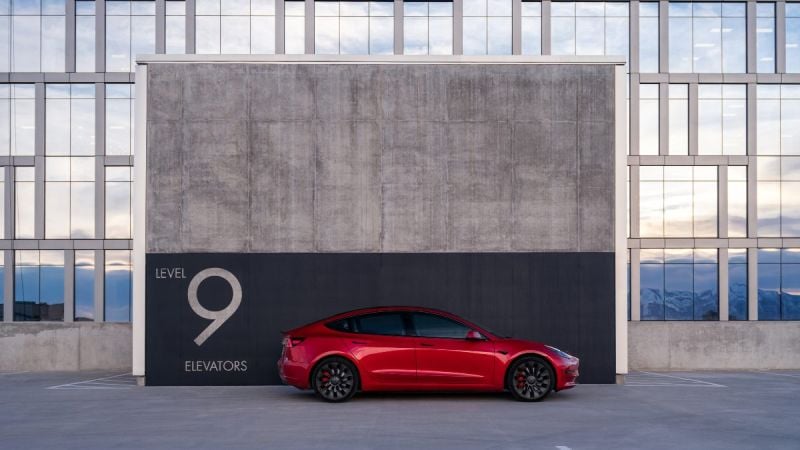All Tesla Model 3 variants, all Model Y variants, and the Model X Long Range qualify for the full $7,500 Federal EV tax credit in 2023.
To take full advantage of these incentives, you need to have a federal tax burden equal to or above $7,500. In addition, income cap restrictions bar people who make above a certain amount of money a year from getting these tax credits.
A New Video Shows a Tesla Cybertruck Getting Rescued by a Ford F-150 After Electric Truck Got Stuck Off-Roading. @Tesla @elonmusk#Tesla
-https://t.co/oAdOb1yVdD
- pic.twitter.com/OT4Hjf6BMJ— Torque News (@torquenewsauto) December 12, 2023
Generally, the income cap is for a single filer $150,000 a year; for a head of household $225,000 a year; and for joint filers $300,000 a year. These caps allow around 90% of individuals and households to claim the $7,500 tax credit.
For 2023, the $7,500 EV tax credit can only be claimed in 2023 tax returns to be filed in 2024. This means most individuals will be out of $7,500 until their next year’s tax refund or will have to take a loan for the extra $7,500 which they will be paying interest on.
However, for 2024, the IRS is changing this rule to allow individuals to claim a $7,500 EV tax credit at the point of sale. This is facilitated by transferring the tax credit to the dealer while purchasing the vehicle. This means individuals can take off $7,500 from the sticker price of the vehicle right from the get-go.
The dealer will then transfer your information to the IRS and receive the $7,500 back from the government organization within 72 hours. After the end of the year, when you file your tax returns, if you happen to fall out of the income bracket on the high end or not accrue $7,500 of tax liability, you will then have to send the IRS the difference in the form of owed tax payments.
In this system, you will be presumed to qualify for the tax credit then by the end of the year for whatever reason if you don’t qualify, you will just end up paying the IRS back the $7,500 that it paid to the dealer.
This is a better system and should make EVs way more affordable to the general public. So what does all this have to do with the Model 3 Performance costing less than the Model 3 Long Range?
Tesla Starts Digging Boring Company Tunnels Under Giga Texas to Efficiently Deliver Parts Directly to the Production Line Through Tunnels @Tesla @elonmusk @WholeMarsBlog #Tesla https://t.co/vuMunNJrBD
— Torque News (@torquenewsauto) December 12, 2023
In 2024, the guidance to receive the $7,500 credit from the car buyers’ perspective becomes more lax however, from the auto manufacturer’s eligibility perspective the rules become more stringent.
Similar to the income limit on individuals to determine whether they are eligible to receive the tax credit some limitations apply to decide whether the vehicle itself qualifies for the credit.
The biggest restrictions are sedans have to cost less than $55,000 to qualify for the credit and for trucks, vans, and SUVs the limitation goes up to $80,000. Tesla Model 3 and S are classified as sedans which means they can only be eligible to qualify for the tax credit if they cost less than $55,000.
This is why the Model X Long Range which costs $79,990 qualifies for the full $7,500 tax credit whereas the Model S Long Range which costs $74,500 does not qualify for the tax rebate.
Both the Model Y and Model X are considered SUVs which means both vehicles qualify for the full federal tax credit as long as they are sold below $80,000. Something to note here is that Tesla’s $12,000 FSD package, not being a physical object that comes attached to the vehicle will not be considered in the final price of the vehicle when determining the tax credit eligibility.
The second limitation concerns whether the vehicle was assembled in North America and where the battery minerals came from. We can go into the weeds regarding this aspect of the eligibility criteria but, long story short, the US government wants less reliance on China.
Tesla’s Head of Vehicle Engineering Confirms the EV maker is Working on a 500-mile Range Cybertruck, Explains Why Tesla Can’t Offer it Yet @Tesla @elonmusk #Tesla https://t.co/UWBv1Bji76
Advertising — Torque News (@torquenewsauto) December 12, 2023
As a result, every year fewer and fewer percentage of the battery components can be sourced from China which currently happens to be the biggest battery supplier in the world.
Tesla’s Model 3 All-Wheel-Drive and Long Range use lithium iron phosphate batteries (LFP) produced by CATL in China. LFP batteries although not as high energy dense as other battery chemistries, are also easy and cheap to manufacture and have extremely high cycle life.
This makes LFP cells ideal to use in battery storage systems and for lower-tier non-performance targeted vehicles, which the Model 3 AWD & Long Range fall under the basket of.
The 2024 IRS guidance that will go into effect on January 1st, as I have mentioned above, although it relaxes the restrictions for individuals to receive the tax credit the new guidance sadly at the same time tightens the restrictions for vehicles to qualify.
According to Tesla, which received clarification from the IRS on the new guidance, come next year, Model 3 AWD and Long Range will both lose the entire $7,500 tax credit.
The Model 3 AWD starts at $39,000; the Model 3 Long range starts at $46,000; and the highest-end Model 3 Performance starts at $51,000.
After subtracting the $7,500 tax credit, in 2023, the Mode 3 AWD starts at $31,500; the Long Range at $38,500; and the Performance at $43,500.
Since the Model 3 Performance uses nickel manganese cobalt (NMC) batteries produced by Panasonic at Giga Nevada, the vehicle will maintain its tax credit and $43,500 starting price.
BREAKING: Tesla has received updated guidance from the IRS. The Model 3 RWD & Long Range will lose the ENTIRE $7,500 Federal EV credit starting January 1, 2024.
Tesla previously thought the EV credit for those trims would be cut to $3,750, but now their interpretation is $0.… pic.twitter.com/VlruMDM31H— Sawyer Merritt (@SawyerMerritt) December 13, 2023
However, at least for the 90% of individuals who qualify for the tax credit, the Model Y Long Range starting at $46,000 will be more expensive than the Model 3 Performance.
These differences are going to be more stark next year since the tax credit will become a point-of-sale reduction. This means you will be paying $46,000 for a Model 3 Long Range when a person next to you walks out of the Tesla store paying $43,500 for his superior Model 3 Performance.
Since Tesla is battery cell constrained, it’s not like the EV maker can simply switch these vehicles to using batteries produced in the US. With some variants qualifying for the point-of-sale tax rebate and others not, Tesla is going to have major price adjustments starting next year.
We’ll be sure to keep you posted as the EV maker adapts to the changing EV tax incentive environment. Until then, make sure to visit our site torquenews.com/Tesla regularly for the latest updates.
So what do you think? Disappointed to learn that the Model 3 AWD & Long Range will lose the entire $7,500 tax credit come January 1st? Also, what do you think will happen for Model 3 Long Range demand now that it’s more expensive for 90% of Americans? Let us know your thoughts in the comments below.
Image: Courtesy of Tesla, Inc.
For more information check out: Tesla’s Head of Vehicle Engineering Confirms the EV Maker is Working on a 500-mile Range Cybertruck, Explains Why Tesla Can’t Offer it Yet
Tinsae Aregay has been following Tesla and The evolution of the EV space on a daily basis for several years. He covers everything about Tesla from the cars to Elon Musk, the energy business, and autonomy. Follow Tinsae on Twitter at @TinsaeAregay for daily Tesla news.











